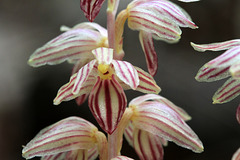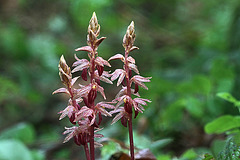RHH's photos with the keyword: mycotrophic
Corallorhiza striata var. striata
| 24 Feb 2015 |
|
|
|
This photograph was taken in Lake Padden Park. It shows one of our more beautiful and unusual native orchids. This plant is without chlorophyll and without leaves and is mycotrophic, obtaining its nutrients through a relationship with a soil fungus. We have four species of Coralroots in the state but this has by far the largest and most beautiful flowers.
Corallorhiza striata var. striata
| 07 Feb 2015 |
|
|
|
This photograph was taken in Lake Padden Park. It shows one of our more beautiful and unusual native orchids. This plant is without chlorophyll and without leaves and is mycotrophic, obtaining its nutrients through a relationship with a soil fungus. We have four species of Coralroots in the state but this has by far the largest and most beautiful flowers.
Corallorhiza maculata var. occidentalis fma. immac…
| 21 May 2014 |
|
|
|
This is a rare color form of a very common native orchid, another Coralroot, the Western Spotted Coralroot. Like all the other Coralroots, it has no leaves or chlorophyll and lives off decaying material in the soil via a relationship with a fungus. The ordinary form of the plant is shown in the inset. This is the "albino" form, lacking the spotting and darker color. It is Corallorhiza (Coralroot) maculata (spotted) var. occidentalis (western) fma. immaculata (unspotted). We have only ever found this once.
Western Coralroot
| 04 Aug 2013 |
|
|
|
The Western Coralroot, Corallorhiza mertensiana, is well named since it is found only in the far western United States and Canada and because its "roots" do look like a mass of coral when dug up. It is mycotrophic, living off decaying matter in the soil through a relationship with a fungus and is leafless and without chlorophyll. It is always a delight to find since it comes in an endless variety of colors, as the photos below show. The color form shown above is more or less typical, but many other color forms are shown below at the link I've posted.
nativeorchidsofthepacificnorthwest.blogspot.com/2012/09/color-forms-of-western-coralroot.html
Phantom Orchid
| 17 Jul 2013 |
|
|
|
The Phantom Orchid, Cephalanthera austiniae, is one of our rarer native orchids. It is also unique in several ways. Cephalanthera is primarily a European and Asian genus with only this species in North America. In the genus this is the only species that is mycotrophic (living off decaying material in the soil) and lacking in color (many species are pink or purple in color), and it is the only North American species that is always white with only a spot of yellow-orange color on the lip. There are white forms of several other native orchids, but these plants are never anything but a stark white that makes them stand out like phantoms on the dark forests floors where they grow. Their lack of color also means, of course, that they are without chlorophyll. This example was photographed in northern California.
nativeorchidsofthepacificnorthwest.blogspot.com/2012/07/three-native-orchids-in-northern.html
Corallorhiza maculata var. occidentalis
| 23 May 2012 |
|
|
This is the Western Spotted Coralroot, distinguished from the ordinary Spotted Coralroot by the shape of the lip. All the Coralroots are leafless and without chlorophyll, deriving their nourishment via a fungus from decaying plant material in the soil.
As usual we are out orchid hunting at every opportunity and this was photographed during an afternoon walk in Sehome Hill Arboretum in Bellingham, next door to Western Washington University. We found three orchids in the Arboretum that day, including several Fairy Slippers and some Striped Coralroots.
nativeorchidsofthepacificnorthwest.blogspot.com/2012/05/t...
Corallorhiza striata var. striata
| 29 May 2012 |
|
This was taken on an afternoon walk in Sehome Hill Arboretum in Bellingham, adjacent to the campus of Western Washington University. It is not an arboretum in the true sense of the word, but a 180 acre park covered with second growth forest and with much of the native flora preserved.
We found two Coralroots on our hike, this, the Striped Coralroot, as well as the Western Spotted Coralroot. This we found in only one location, the other in quite a number of locations along the trails, though if we had had more time I'm sure we could have found more.
Like all Coralroots, these are leafless, without chlorophyll, and live off decaying plant material in the soil (they are mycotropic). This species has another variety with much smaller flowers that is much more rare and not as showy.
nativeorchidsofthepacificnorthwest.blogspot.com/2012/05/t...
Corallorhiza striata var. striata
| 05 Jun 2012 |
|
These Striped Coralroots are finished blooming now except at higher elevations, but are one of our favorite native orchids, and one we always look for when in bloom. They have the largest and most beautiful flowers of all the Coralroots in our area and are also more difficult to find than many of the others.
This photo was taken in Larrabee State Park on the coast and on a rainy day. We found a lot of Striped Coralroots there this year, perhaps due to the late, cold and wet spring. Larrabee is in the Chuckanut Mountains and is a wonderful place both for its wildflowers and for its tide pools.
The Coralroots are mycotropic plants, without leaves (which makes them hard to find when not in bloom) and without chlorophyll, deriving their nourishment from the soil through a relationship with a fungus (funny thing with which to have a relationship, but that's the way it is). Interesting plants!
More photos and text here: nativeorchidsofthepacificnorthwest.blogspot.com/2012/05/s...
Corallorhiza mertensiana
| 10 Jun 2012 |
|
|
This is another one of our native Coralroots, a genus of plants that are almost entirely without leaves or chlorophyll. They are referred to as mycotrophic, which means that live in a symbiotic relationship with a fungus and through the fungus obtain nourishment from decaying material in the soil.
These plants often grow on the darkest forest floors where nothing else is growing except the trees which form the canopy above. There they grow among a litter of old branches and decaying logs, and the lighter colored forms stand out vividly in the dark.
This species, known as the Western Coralroot, is extremely variable in color, the stems and flowers parts ranging from this deep reddish-purple to pale lavender, yellow and off-white. These plants, photographed in Washington Park, are some of the darkest colored examples I've seen.
They are quite common and we see them this time of the year on many of our hikes, but you would have to come out our way to see them, since they grow only out west. You'd have to experience our weather, too. This was taken on a wet and windy day that made photography very difficult.
More photos here:
ronaldhanko-orchidhunter.blogspot.com/2012/05/spring-in-w...
nativeorchidsofthepacificnorthwest.blogspot.com/2012/05/f...
Corallorhiza mertensiana fma. pallida
| 05 Feb 2013 |
|
The is the Western Coralroot, but a very pale form. We found these at Lake Elizabeth several years ago, but discovered this past summer that someone had destroyed the site to make a campsite. Only a few stems were left back among the trees. The Coralroots are leafless and without chlorophyll and depend for nourishment on a fungus (they are mycotrophic). This species is very variable in color as the link below shows. The species is found only in thee far west but is very common throughout our area.
Many different color forms can be seen here: nativeorchidsofthepacificnorthwest.blogspot.com/2012/09/c...
Corallorhiza striata
| 19 Feb 2013 |
|
This photo was taken earlier in the year In Larrabee State Park, but not at Clayton Beach. Near the main road through the park, Chuckanut Drive, there is a walking and biking trail, the Interurban Trail, that follows the road for many miles. This photo was taken along that trail at a spot where we go to see these orchids every year.
Corallorhiza striata has the largest and showiest flowers of any of our native Coralroots. It blooms in the spring and is usually found growing in rather sheltered and shady areas. In this particular location it can be found in some large clumps if they survive the dogs and bikes and hikers who use the trail, but usually they do and people who use the trail seem quite careful to use it responsibly.
All the Coralroots are leafless and without chlorophyll. They live in a symbiotic relation with a fungus and through the fungus obtain their nourishment from decaying material in the soil. Washington has five species of Coralroots, maculata, mertensiana, striata, trifida and wisteriana, plus several important varieties of these species.
nativeorchidsofthepacificnorthwest.blogspot.com/2012/05/s...
Western Spotted Coralroot
| 27 Feb 2013 |
|
Another of the native orchids that grows at Goose Rock, this one photographed along the trail to the top. There were a lot of these, but most of them just a stem or two. This large clump was one of the best examples we've seen.
ronaldhanko-orchidhunter.blogspot.com/2012/06/whidbey-isl...
Jump to top
RSS feed- RHH's latest photos with "mycotrophic" - Photos
- ipernity © 2007-2025
- Help & Contact
|
Club news
|
About ipernity
|
History |
ipernity Club & Prices |
Guide of good conduct
Donate | Group guidelines | Privacy policy | Terms of use | Statutes | In memoria -
Facebook
Twitter












